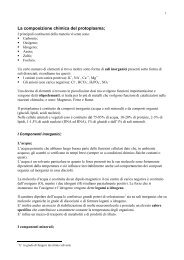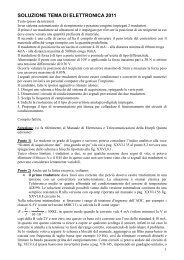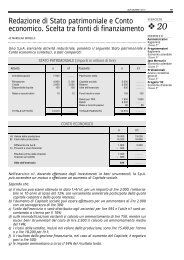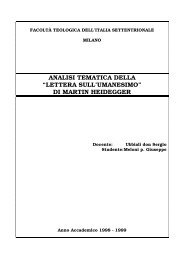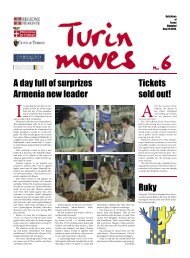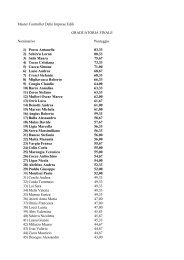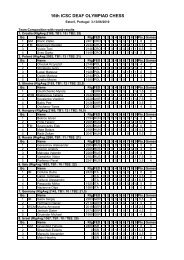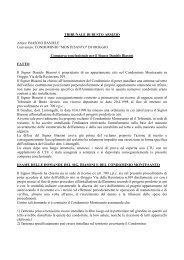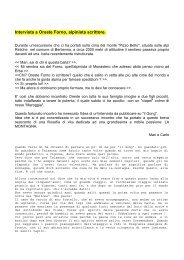COMUNICAZIONE MEDICO-PAZIENTE E ADERENZA ALLA TERAPIA
COMUNICAZIONE MEDICO-PAZIENTE E ADERENZA ALLA TERAPIA
COMUNICAZIONE MEDICO-PAZIENTE E ADERENZA ALLA TERAPIA
Create successful ePaper yourself
Turn your PDF publications into a flip-book with our unique Google optimized e-Paper software.
18. Melkote S. R., Muppidi S. R., Goswami D., (2000) “Social and Economic Factors in an IntegratedBehavioural and Societal Approach to Communications in HIV/AIDS”, Journal of HealthCommunication, volume 5, pp. 17-27.19. Bandura A., (1992), “A social cognitive approach to the exercise of control over AIDS infection”, inR. J. Di Clemente (Ed.) “Adolescent and AIDS: A Generation in Jeopardy”. Newbury Park, CA.Sage.20. Bandura A., (2000) “Autoefficacia – Teoria e applicazioni”, Ed. Ital. Erikson, Trento.21. Rosenstock I. M., Stretcher V., & Becker M., (1994), “The Health Belief Model and HIV riskbehaviour change” in R. Di Clemente & J. Peterson (Eds), “Preventing AIDS: Theories andmethodes of behavioural interventions” (pp. 5-24). New York:Plenum.22. Jemmott III J. & Jemmott L., (1994), “Interventions for adolescents in community settings” in R. DiClemente & J. Peterson (Eds), “Preventing AIDS: Theories and methodes of behaviouralinterventions” (pp. 5-24). New York:Plenum.23. Fee E. & Krieger N., (1993), “Understanding AIDS: Historical interpretation and limits ofbiomedical individualism”, American Journal of Public Health, 83, 1477-1486.24. Quinn S., (1993) “AIDS and African American Women: the triple burden of race, class andgender” Health Education Quarterly, 20 (3), 305-320.25. Auerbach J., Wypijewska C & Brodie K., (1994) “AIDS and behaviour: An integrated approach”,Washington, DC: National Academy Press.26. Ley P., Bradshaw P. W., Kincey J. A., & Atherton S. T. (1976a), “Increasing patients’ satisfactionwith communication”, British Journal of Social Clinical Psychology, 15, 403-13.27. Parkin D. M., Henney C. R., Quirk J., Crooks J, (1976), “Deviations from prescribed treatmentafter discharge from hospital”, British Medical Journal, 2, 686-8.28. Donovan K., (1993) “Breaking Bad News”, pp. 1-14, in “Communicating Bad News. BehaviouralScience and Learning Modules”, Division of Mental Health, World Health Organization, Geneva.29. Premi J. N., (1993) “Communicating Bad News to Patients”, pp.15-25, in “Communicating BadNews. Behavioural Science and Learning Modules”, Division of Mental Health, World HealthOrganization, Geneva.30. Korsh B. M., Gozzi E. K. & Francis V., (1968) “Gaps in doctor-patient communication”, Pediatrics,42, 855-71.31. Roth H. P., Caron H. S., Ort R. S., Berger D. G., Merrill R. S., Albee G. W. & Steeter G. A., (1962)“Patients’ belief about peptic ulcer and its treatment”, Annals of Internal Medicine, 56, 72-80.32. Ley P., (1972a) “Complaints by hospital staff and patients: a review of literature”, Bullettin of theBritish Psychological Society, 25, 115-20.33. Roter D. L., (1977) “Patient participation in the patient-provider interaction: the effects of questionasking on the quality of interaction, satisfaction and compliance”, Health Education Monographs,5, 281-315.



